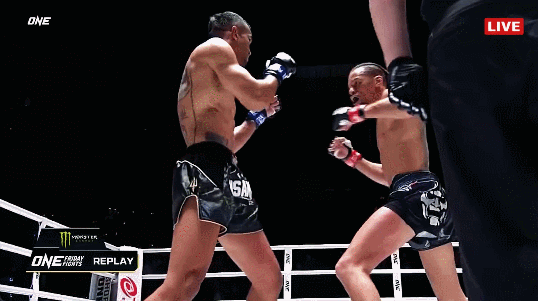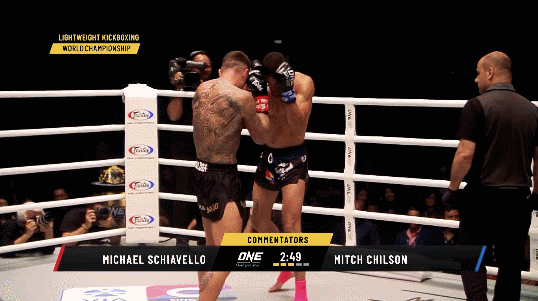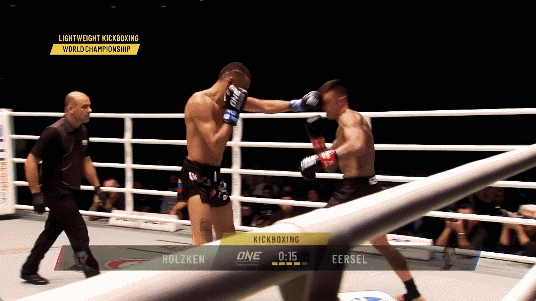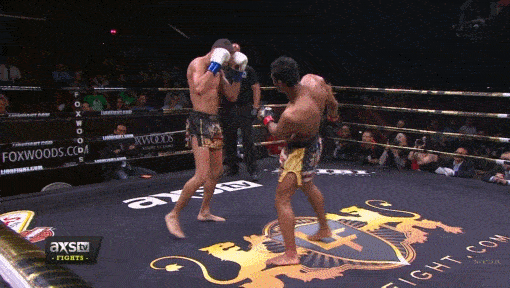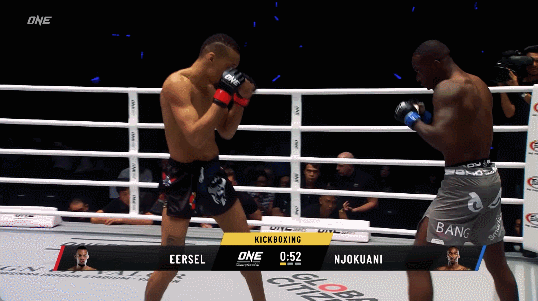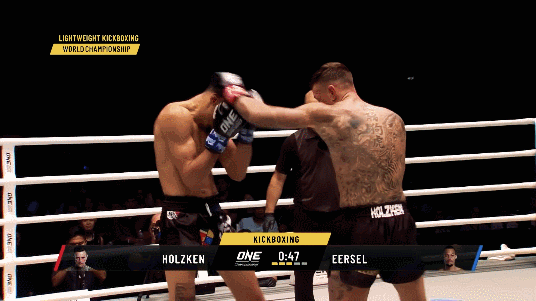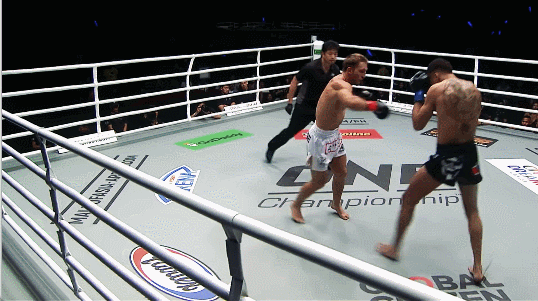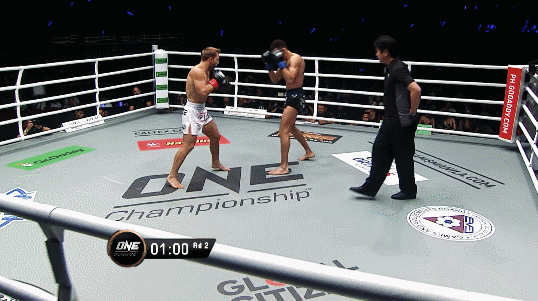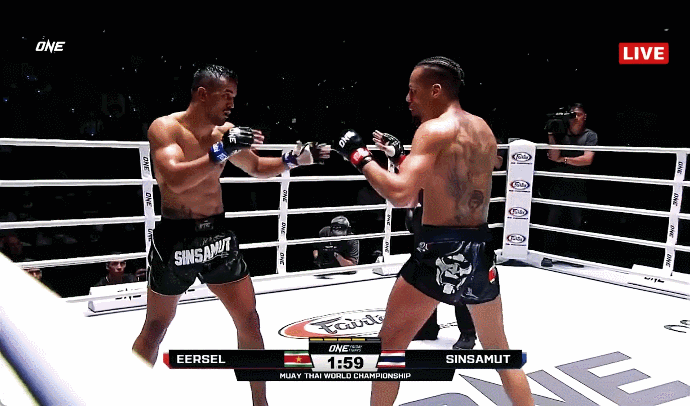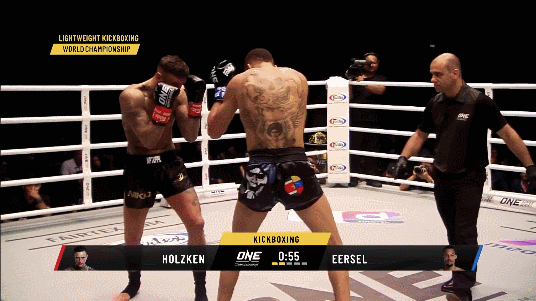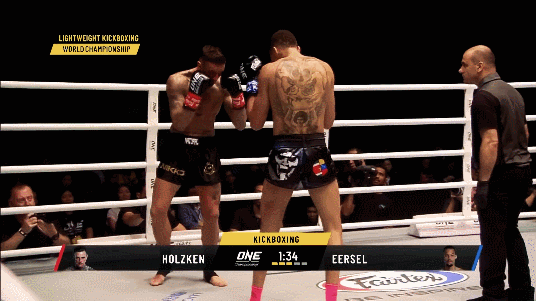Regian Eersel – ONE’s Striking Superman
To study the career path of Regian Eersel is to study the expansion and refinement of ONE Championship. ONE had been in business as a mixed martial arts organization since 2011 but only introduced its “Striking Series” of kickboxing and Muay Thai rules fights in 2018 and these have quickly become the meat of their best cards. Eersel fought Brad Riddell in ONE’s first kickboxing bout on the Heroes of Honour card back in April 2018, and his career in ONE reflects the changing ruleset that ONE has experimented with since that time.
In his second ONE fight, Eersel knocked out Anthony Njokuani under kickboxing rules, but in four ounce gloves—a format that ONE quickly dropped. He defeated Nieky Holzken for the inaugural ONE Lightweight kickboxing title in the ring, but fought the immediate rematch in the larger, obviously-less-square cage. Then when ONE started offering full Muay Thai rules in four ounce gloves, Eersel jumped across to win and defend a separate belt under that format.
There is plenty of footage of Eersel competing under both kickboxing and Muay Thai rules—including his run in Lion Fight—and while his skill set continues to grow, his Muay Thai fights are still largely just his kickboxing style, with the occasional elbow. On the one hand that could be seen as not making the most of the ruleset, but on the other it points to a sort of “all terrain” style which can be dropped into either ruleset and prove about as effective.
Since his ONE Championship debut, Eersel’s table setter has become the jab to inside low kick. As he is taller than the majority of his opponents, Eersel can use the jab to step into range and follow with the inside low kick, or he can use a jab and low kick straight out of the stance when crowded by his opponents. Because he can stay behind his lead shoulder, can frame off the opponent with the jabbing hand, and can break their balance by kicking the lead leg out if they get aggressive, this simple two-shot point scorer has become a constant in many of his fights.
Over ten rounds with Nieky Holzken, when Eersel wasn’t doing something clever, or was fighting on auto-pilot, it was this pair of strikes that got put out with little commitment and little punishment from Holzken. When he did want to push his chances, he could continue a combination off the low kick.
Eersel’s right hand is a key component in his style and, due to his height and length, can hurt opponents from a good distance. But the subtle step out is what allows Eersel to either disengage or continue with his marching combinations.
Figure 1 shows a comparison between Eersel’s right straight and a traditional right straight. In both a) and b) the X represents the centreline of the opponent or the point of their chin. In a), the fighter takes a step forwards and slightly to the left in order to line up the straight, but the movement is predominantly forwards. The third frame of example a) shows the optional advance of the right foot, either with the right hand or following it. That, of course, depends on the follow up.
Fig. 1
Example b) shows the way the Eersel often throws his right hand. Stepping more to the left than forwards, sometimes pivoting on his back foot so that he almost looks as though he is going for a walk past the opponent. This is commonly seen when fighters throw a big overhand swing, but Eersel steps out to his left on almost every right punch. The length of his step varies as Eersel often likes to keep a high stance and continue with knees. Sometimes he will break off the attack at the right hand and, where in a normal boxing or kickboxing position that would be dangerous, he goes unpunished. This is because he doesn’t always need to “close the door” and get back to a bladed orthodox stance if he is bladed behind his right shoulder and can continue circling off to his left, ducking down behind his right arm if he needs to.
By stepping wide rather than long, Eersel also makes it easier to step again and march into a left kick or a left knee. This is the staple of his combination work and it just wouldn’t be possible if he were stepping straight in with good form for a crisp 1-2 from the boxing textbooks.
Eersel’s wide stepping right hand does often require extra movement though because he is going off to the side and his opponent is often retreating. Here Eersel steps out and is set to throw a low kick, but has to take an extra shuffle step just to make the distance even though Holzken hasn’t gone far.
The downside of this right hand is that following with a good left hand is difficult. Returning to Figure 1, in example a) the fighter can turn their hips clockwise and fling the left hook straight through the opponent’s centreline. In example b) the fighter will often throw the left while his right foot comes back underneath him and end up pivoting on the left foot, sliding down the opponent’s right side. The big weakness of throwing the right hand in this way—sort of halfway to the dart—is that if the opponent circles to their left it can make following up very difficult.
This can be used by the offensive fighter though. Since his early career, Eersel has loved throwing the right high kick off the right hand. We have spoken before about how this technique is having a moment in the sun after being used to score several high profile MMA knockouts, but you can see how Eersel’s step opens his hips to kick Jo Nattawut while he is basically on Eersel’s right flank.
That is an extreme example as Eersel was going for broke in the dying moments of a close fight, and Nattawut had been leaning wide throughout, but you can see Eersel throwing up less committed straights to high kicks against Njokuani and applying the same principles.
If you want to do two-fisted hitting and have equal threat in both hands it’s better to step in on, rather than down the side of the opponent. But if you want to march forward and start stepping through into knees anyway, it can be a better way to begin.
We’ve been using the term “right straight” to this point, but Eersel will use right overhands and hooks depending on the opponent. His overhand can be seen most often against the rare opponents who match him for height. His second fight with Sinsamut saw Eersel pitching overhands instead of straights, but also breaking off after the right hand and rarely marching up to follow on. This was most likely caution due to the volatile nature of entering extended trades in smaller gloves.
Eersel will use a tight right hook in very specific instances to crowd opponents along the ropes. He used this a couple of times against Holzken but the best example is his knockout punch against Njokuani. Here the deep step to ten o’clock allows Eersel to throw his weight into the direction of the blow.
The biggest selling point of Eersel’s right hand is how it allows him to march into his left knee though. Putting the left foot out to the side opens up his hips to march without a long step through or a switch step. Consider how long a step you would have to take with the right foot were you maintaining a traditional boxing position on your right hand.
Eersel’s knees account for much of his success. The great Dutch coach, Lucien Carbin once remarked that a standing knee strike is “like an atom bomb” and expressed frustration that they are not constantly being thrown in combinations in kickboxing. His charge, Andy Ristie shot to the top of the kickboxing world like a bolt from the blue by throwing stepping knees amid blistering punching combinations, and Eersel fights in a similar mold. He is taller than most of his opponents, he can bring his knee up to their chin at any time, and so not a round goes by where he doesn’t try to catch them with it at least once.
If there is a lull in the action and his opponent is standing in exchanging range, perhaps in a double forearms cover up as most kickboxers are wont to do, Eersel will throw up a quick knee to their chin.
But Eersel’s best work is done with knees to the body. In some of Eersel’s toughest contests, such as the first Holzken fight and the Brad Riddell fight, his body work with his knees has made the difference.
Riddell was outscoring Eersel nicely with punching flurries and breaking from the line of attack to avoid Eersel’s returns. Eersel recognized that in order to punch Riddell’s elbows must leave his body and so Eersel set to work intercepting him with knee strikes. If you were not already aware that Brad Riddell is tough as nails, take a look at some of the intercepting knees he absorbed in the course of this bout and note that he barely slowed from his original pace.
One particularly nasty look that edged Eersel ahead was his use of knees as he rebounded off the ropes. The moment his back hit the ropes, Riddell was of course going to open up with punching combinations. So the worst spot in the ring also became the best place to score with counter knees. Israel Adesanya also used this tactic to knock down Robert Thomas in Glory.
Never a fan of fighting conservatively behind his reach, Eersel goes after his opponent, forces exchanges, and finds knees as the opponent’s elbows leave their sides. A signature strike that Eersel scored against both Riddell and Holzken is a jumping knee to the midsection. You will see plenty of fighters throw a dozen flying knees at their opponent’s head every fight and very rarely find one. Eersel tends to use the flying knee as a mid-exchange weapon, straight into the opponent’s ribs.
Two weeks ago we discussed Ryusei Kamugai using the shovel hook to the body as a taller fighter in his division. Regian Eersal doesn’t go to it with the same frequency as Ryusei, but when he does use the shovel hook he makes it count. His second fight with Sinsamut was finished out of nowhere with a well placed hook to the body.
He also used it to steal Sergej Braun’s soul when Braun came out fast and had the Dutchman rattled.
The deceptive power of this short hook can be easily seen in the Brad Riddell fight. We have already examined the dozens of hard knees Riddell took flush with complete stoicism. It was one sneaky left hook to the liver that traveled only a few inches and put Riddell down in the second round. In a bout where neither man gave an inch, this knockdown proved to be everything, winning Eersel the fight on the cards.
Moving away from these spectacular knockdowns, it is Eersel’s consistent, less eye catching use of the left hook to the body that impresses. Big body shot knockdowns and knockouts can be used to convince a fighter to commit to bodywork, but most then give up as soon as the one shot knockdowns don’t happen. Eersel’s game is a torrent of offence and his dig to the liver works beautifully in combination, draining opponents and setting up further offence.
This writer’s favourite Eersel combination employs the same principles as Nieky Holzken’s famous right uppercut - left hook to the liver combination. Eersel throws the left hook to the liver, crunching his oppponent forwards, followed by the right uppercut to stand him up, and then returns to the liver with a left knee. Two body shots in a three strike combination is the kind of ratio I can get behind.
The right uppercut to left knee is a staple for Eersel on its own though. He will use the right uppercut to march through into the left knee, or sometimes perform a switch step on the uppercut itself—in the style that is becoming increasingly popular (though not particularly effective) in Japanese kickboxing.
ONE Championship’s weird divisions have Eersel called their "lightweight” champion but he is considered a welterweight in kickboxing at large. Where most divisions have a clear top dog right now, opinion on the welterweight division is divided as to whether Regian Eersel or GLORY’s welterweight champion, Endy Semeleer is the best welterweight going. While it might seem like a match up between the two is unlikely, contracts expire and transfers happen quickly in boxing. It wasn’t so long ago that ONE poached Sittichai and Marat Grigorian, basically GLORY’s entire lightweight title picture.
Whoever he fights next, Regian Eersel has found his place in the fighting world. Last weekend Eersel was the star of the show as he defended his kickboxing title against Dmitry Menshikov, a consensus top five welterweight, only to knock Menshikov out with a stepping left hook inside a minute. His style was made for an audience and he is hitting his stride at the perfect time to be front and centre in all of ONE Championship’s striking related endeavours.




